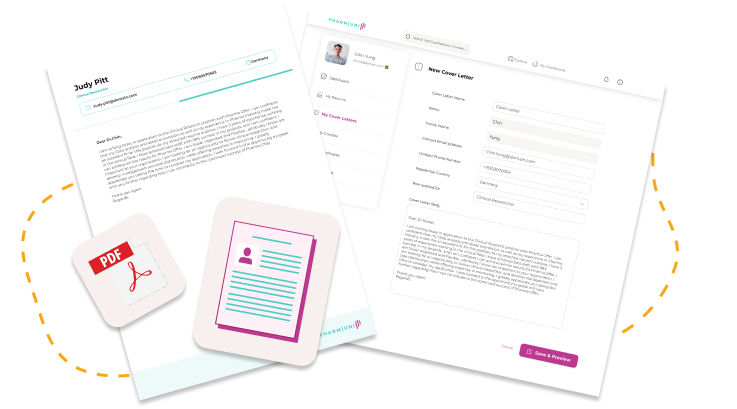Unlock the potential of your career in the Pharma industry with our online courses and qualifications.

Pick a career path, follow its guided course roadmap, and secure industry-verified credentials in a few months.

Earn career credentials from industry leaders that demonstrate your expertise.
Are you looking to make a strong impression with your job applications? Our Professional Cover Letter Builder is specifically designed for professionals in the pharmaceutical industry, helping you craft impactful cover letters that highlight your unique skills and experiences.

Personalization is crucial. Customize every cover letter for the specific position you’re applying for. With our customizable industry-specific templates, you can easily modify the content to reflect the job description and integrate the company name, demonstrating your genuine interest.
Capture attention from the get-go! Our professionally-designed templates help you format your cover letter effectively so that your compelling introduction stands out, setting a positive tone right away.
Showcase your qualifications effectively. Use our builder to list your key accomplishments clearly, ensuring they stand out within a clean and professional layout that captures the reader’s attention.
Let your enthusiasm shine! Utilize our Easy Pharma Cover Letter Maker to seamlessly incorporate personal insights about your dedication to the pharmaceutical field, making a connection with hiring managers and leaving a memorable impression.
Finish strong! Our templates guide you in crafting a closing statement that reiterates your excitement about the role and expresses eagerness for an interview. A structured conclusion enhances your professional image and encourages further engagement.
Experience an intuitive design process with our builder, allowing you to create your cover letter effortlessly—no design skills needed! Download your finalized document in multiple formats (PDF, Word) or share it directly with a personalized link, giving you the flexibility to apply as needed.



Looking for a quick and easy way to create a compelling cover letter that stands out?
Our simple-to-use cover letter maker helps you build a professional letter in minutes. Whether you’re just starting out or applying for senior-level positions, our tool has you covered with customizable templates tailored to your needs.

Our builder, designed by pharma experts, adapts to your career level—beginner or executive—to help you create cover letters tailored to the pharmaceutical industry.
Just fill in your details and we’ll format the letter for you. Our easy-to-use platform lets you build your cover letter in minutes – no more stressing over formatting or design.
Tailor each cover letter to the specific job you’re applying for. Highlight your qualifications and align your message with the company’s values and needs.
Once you’ve created your cover letter, you can apply directly to job boards using our platform, streamlining your job search and saving time.
Pair your cover letter with our resume builder to complete your application. Together, they form a cohesive, professional package that impresses employers.

Transform your career prospects today with the Pharma Cover Letter Builder. It’s time to create a professional Cover Letter that opens doors to new opportunities.
We use cookies to improve your experience on our site. By using our site, you consent to cookies. Privacy Policy
Manage your cookie preferences below:
Essential cookies enable basic functions and are necessary for the proper function of the website.
These cookies are needed for adding comments on this website.
Google Tag Manager simplifies the management of marketing tags on your website without code changes.
These cookies are used for managing login functionality on this website.
Statistics cookies collect information anonymously. This information helps us understand how visitors use our website.
Google Analytics is a powerful tool that tracks and analyzes website traffic for informed marketing decisions.
Service URL: policies.google.com
Clarity is a web analytics service that tracks and reports website traffic.
Service URL: clarity.microsoft.com
Marketing cookies are used to follow visitors to websites. The intention is to show ads that are relevant and engaging to the individual user.
Facebook Pixel is a web analytics service that tracks and reports website traffic.
Service URL: www.facebook.com
LinkedIn Insight is a web analytics service that tracks and reports website traffic.
Service URL: www.linkedin.com
You can find more information in our Privacy Policy and Privacy Policy.